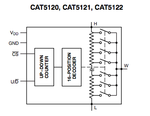faisal78
Member level 3
Hi
I would like to make a simple volume knob using discrete resistor ladder.
For example, using 15 discrete resistors, i can use a ADC to discretely define 16 voltage levels to determine the volume knob position.
The bad thing about this circuit is, as I have only a single "wiper", as I am going in between resistor "pad", there is a finite time that the ADC may sample 0V? this will happen every time i am going between resistor values.
How can I easily solve this electronically? I know I can solve it using daul "wipers" mechanically.
Even by using a Sample & Hold circuit, there may be an occurrence that I may sample 0V.
Any idea's?
I would like to make a simple volume knob using discrete resistor ladder.
For example, using 15 discrete resistors, i can use a ADC to discretely define 16 voltage levels to determine the volume knob position.
The bad thing about this circuit is, as I have only a single "wiper", as I am going in between resistor "pad", there is a finite time that the ADC may sample 0V? this will happen every time i am going between resistor values.
How can I easily solve this electronically? I know I can solve it using daul "wipers" mechanically.
Even by using a Sample & Hold circuit, there may be an occurrence that I may sample 0V.
Any idea's?
